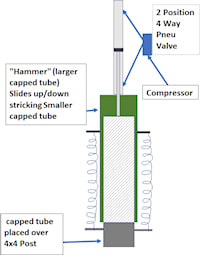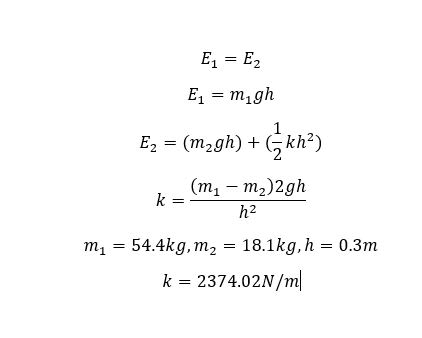FoxLair
Agricultural
- Jan 17, 2019
- 7
Full Disclosure - I am a building contractor with an affinity to design ways to reduce labor and/or allow me to complete tasks in an efficient way.
I have built permanent docks that utilize 4x4 treated posts driven into the lake bottom. Large pneumatic drivers work great but require an 80+ CFM compressor and a floating platform with a hoist of some sort to operate. On repairs. I have used a hand driver that is square metal tube with a cap and handles welded on. To automate this I added a Pneumatic cylinder to raise and lower this capped tube. It operates on a 5-6 CFM air compressor and works great.
Now the question: My goal is to drive a post with minimum blows while maintaining portability. I can add more mass, add springs or change pneumatic design. I understand how free falling mass and velocity affect impact. But, what makes my brain hurt is determining impact force when i add a pneumatic cylinder pushing downward at a specific PSI. Further brain strain is how adding a tension spring affects impact force (Given an extension spring constant (K), and a distance (d), how does this affect impact force of a falling mass)
What I can speculate is that either Air pressure or springs can increase velocity. I don't need exactness here, I just need to understand how I can better predict outcome and lessen trial and error time (of which I have invested a bunch).
Please help my poor brain in its hour of need.
I have built permanent docks that utilize 4x4 treated posts driven into the lake bottom. Large pneumatic drivers work great but require an 80+ CFM compressor and a floating platform with a hoist of some sort to operate. On repairs. I have used a hand driver that is square metal tube with a cap and handles welded on. To automate this I added a Pneumatic cylinder to raise and lower this capped tube. It operates on a 5-6 CFM air compressor and works great.
Now the question: My goal is to drive a post with minimum blows while maintaining portability. I can add more mass, add springs or change pneumatic design. I understand how free falling mass and velocity affect impact. But, what makes my brain hurt is determining impact force when i add a pneumatic cylinder pushing downward at a specific PSI. Further brain strain is how adding a tension spring affects impact force (Given an extension spring constant (K), and a distance (d), how does this affect impact force of a falling mass)
What I can speculate is that either Air pressure or springs can increase velocity. I don't need exactness here, I just need to understand how I can better predict outcome and lessen trial and error time (of which I have invested a bunch).
Please help my poor brain in its hour of need.


